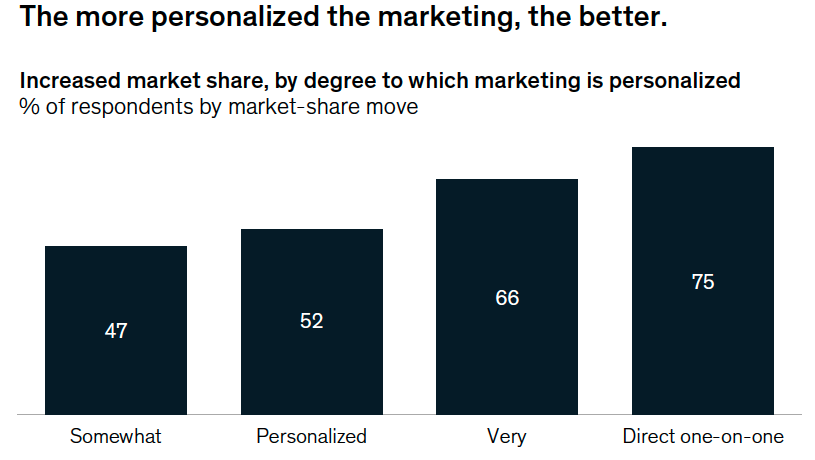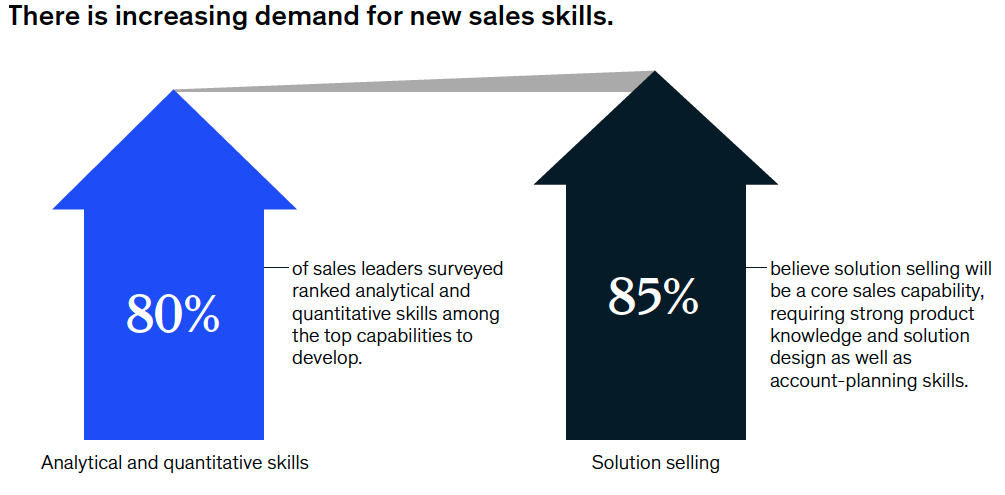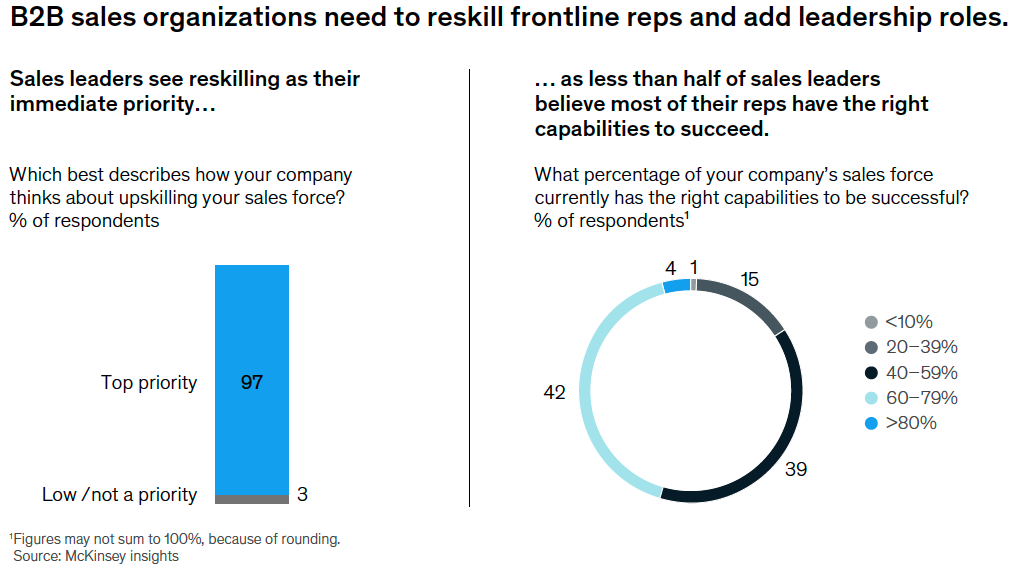No doubt about it—the pandemic accelerated dramatic changes in the B2B selling landscape. Buyers made radical shifts in how they interacted with sales reps and make purchase decisions. Meanwhile, the customer journey has evolved into a solidly omnichannel one.
Probably the most pervasive change—one whose impact is reverberating through companies of all sizes—is the urgent demand for customer centricity. With the buyer having more control of the sales process, sales leaders must better equip their teams to meet buyer needs and ensure customer engagement.
The authors of a November 2022 McKinsey & Company report, Future of B2B sales: The big reframe, tackled this topic by surveying more than 50 heads of sales in various industries. We’ve summarized their insights and key takeaways here and added our recommended best practices to help you realize higher sales volume in 2023 by keeping customers front and center.
Put the customer at the heart of growth
Customers expect vendors to demonstrate industry, market, and product expertise. And top performing sellers are less focused on the sales funnel and more obsessed with guiding customers on a personalized buying journey that shows they’re in tune with their customers’ needs and wants. How can you create a customer-centric culture?
Customer-Centric Best Practices: Engagement
- Gather and analyze comprehensive data on customer intent preferences, and translate those insights into impact. Ensure that offline and online channels align and work in tandem as a unified entity, rather than as separate channels. Ideally, all departments within the organization – from operations to merchandising to advertising to finance – must come together and share data, share feedback, and keep tabs on real-time customer behavior so sales activities remain spot-on and relevant to current needs. By combining data drawn from direct customer conversations, surveys, and other sources, teams can personalize content that speaks to individual decision-makers and influencers in specific accounts or industries.
- Offer B2C-grade, personalized content with tailored value propositions for every stage of the buying journey. It’s a surprising fact that B2B content outweighs both sales presentations and timeliness in influencing a customer’s purchase. Customized, informative, and comprehensive content demonstrates credibility and expertise and convinces the customer that they’re getting an end-to-end partner.
- Monitor customer conversion readiness and prepare to deliver a consistent experience across the entire buying journey that delights customers. Using unexpected sources of decision-making data at a granular level can provide rich signals that give a fully rounded view of the customer. For example, companies are identifying customer buying opportunities by tracking prospects’ hiring patterns. If a manufacturer starts recruiting data scientists, you may infer that they’re in the market for data infrastructure, and you can target your marketing and sales efforts accordingly.

Source: McKinsey & Company
Break the channel mindset
Digitally savvy customers have assured B2B companies that hybrid engagement is here to stay, so stop relying on a single channel to connect with customers.
In fact, research shows that customers no longer distinguish channels; instead, they anticipate seamless buying from companies that respect their wish to engage when and where they want. And closing high-dollar deals without a vendor meeting is increasingly common.
Customer-Centric Best Practices: Sales Channels
- Make hybrid your default approach. To succeed, sellers must be experts at both remote and in-person selling. It’s essential for them to understand what makes buyers tick in both physical and virtual settings so they can gauge and customize the right mode and level of engagement at the right time. They should be able to judge the best form of interaction they need to use for different contexts and situations at every stage of the customer’s journey.
- Optimize the channel experience for each step of the customer-buying process. Customers expect to interact via a mix of in-person, remote, and self-serve methods, and businesses that can satisfy customers’ needs at every touchpoint will stay ahead of the pack. McKinsey found that B2B buyers now spend a third of their time engaging with self-serve content across all stages of the buying journey, including at the moment of purchase and for high-complexity products. Downloadable demos, virtual webinars, digital marketplaces, video libraries, and online communities all help to equip B2B customers with the content they need when and at the point where they want it.
- Find creative ways to complement traditional sales channels to uncover new ways of engaging customers and sources of revenue. The hybrid model allows in-person sellers to use technology to optimize their sales activities, such as applying speech analytics to customers’ verbal cues or analyzing video footage to clarify and better respond to customer questions. Some companies go further and establish buyer communities—platforms where buyers can engage with each other free from intermediation by the seller—creating a safe haven for customers to express opinions and seek peer advice on the best ways to use a company’s products or services. Such platforms can also be used to collect direct feedback from customers.
Make your sales processes customer-centric
Reorient your sales motions toward your customers. Putting their needs at the center of your processes will require your team to shift their thinking away from traditional sales toward helping their customers succeed. Your customers will take notice, and you’ll earn their trust, win their loyalty, and grow revenue.
Customer-Centric Best Practices: Sales Strategy
- Use cross-functional “win rooms” or hubs to refine sales solutions to fit customer needs. A win room combines representatives and input from marketing, product, delivery, finance, and technology to clearly define the KPIs, meeting cadence, roles, and processes needed to best serve both key accounts and your broader customer population.
- Focus on a narrow set of tools and technologies that drive targeted customer outcomes rather than on those that merely solve technical problems. Be open to instituting innovative processes and people dedicated to delivering a better omnichannel experience for customers. Make sure your approach and your systems remain flexible so you can quickly adapt to both technology advances and customer behavior changes.
- Start with the outcome in mind when exploring new tech tools. How will this new technology impact your customers? Assess and be clear on what your sales reps actually do and what they need to accomplish. Don’t invest in new tech until you’ve confirmed it will move the customer experience needle and have determined there’s a good fit for your stated purpose. Emphasize quality over quantity. A multitude of fragmented solutions is inefficient and can be confusing to sales reps. Opt for fewer tools that are easily integrated.
- Elevate the commercial operations function into a clear and strategic role in the overall business. Setting sales quotes, managing sales tech, and improving rep productivity are the traditional responsibilities of commercial operations. But operating under a customer-centric approach demands that companies expand commercial operations as a source of analytical and strategic value. Some organizations have successfully combined sales operations, marketing operations, and customer-success operations in a way that improves effective collaboration and information sharing and, ultimately, the customer experience. Unifying functions in this way can streamline processes and strengthen the ability of otherwise divergent teams to drive in a customer-centric direction.
Rethink the people strategy in the age of attrition
In addition to the challenges of attrition, sales leaders must overcome traditional hiring approaches and realize that today’s hyper-informed customers demand sellers display a fresh set of capabilities.
Vendors are not merely competing with other vendors; they are also confronting internal conflict as they assess the most effective way to earn the customer’s time and attention. As in-person sales have given way to videoconferencing, online chats, and e-commerce, sales reps must have new skills if they are to maintain sales performance.
Companies don’t have to go offshore to expand their talent pools. Remote, off-site domestic teams with deep sales experience can deliver next-generation skills that delight customers.
Customer-Centric Best Practices: Sales Talent
- Equip field and inside sales reps and net-new hybrid sellers with the most relevant sales skills to a customer-centric model. As you ramp up hiring and training, keep in mind the strong need for analytical, strategic, and technical skills. Reps should be tracking customers’ business objectives, monitoring customer behavior patterns and observing shifts, and ready to adapt their tactics accordingly.
- Use analytics to craft training programs that empower sellers to prioritize your customers’ long-term success over short-term company gains. McKinsey research shows that companies can boost sellers’ lifetime value 10% by making the right hires, optimizing onboarding, building capabilities, and retaining the right people. At every stage of a salesperson’s tenure, use psychometrics, behavioral data, performance, and relational analytics, organizations to build targeted interventions.
- Break away from traditional sales incentive structures. The pressures of meeting targets against economic uncertainty may cause reps to ignore long-term account management—or worse, provoke leaving for another sales gig. Recognizing reps’ personal motivations can drive retention. Go beyond financial incentives. A recent survey* found that 42% of new, Gen Z workforce recruits care more about a company’s values, purpose, and culture than about salary. Focus on mentorship, career opportunities, and flexibility to keep younger reps on board.
*Hillary Hoffower, “Money isn’t everything for the 20 percent of people who regret quitting their jobs during the Great Resignation,” Business Insider, April 19, 2022.

Source: McKinsey & Company

Source: McKinsey & Company
Make the Change Stick
A radical transformation in B2B selling toward customer-centricity is already a fact, and as change continues, sales leaders must embrace it in their behaviors, their policies, and corporate culture and inspire others to do the same.
Customer-Centric Best Practices: Culture
- Define a simple, compelling, customer-centric vision that the whole sales organization can understand. Capture the essence of any significant shift in sales effort as an easily applicable concept with a singular aim. Then, gain buy-in from the top down, inclusive of every employee.
- Role-model change from the top. When sellers see their senior leaders doing what they’ve been preaching to the frontlines, they will be more apt to model that behavior in their own sales activities.
- Embrace the “two-pizza” rule: adopt nimble cross-functional teams (small enough to be fed with just two large pizzas). Change happens faster with small, agile teams. Consider giving them free the ability to make decisions autonomously and revamp a clunky process into something that is faster and more efficient. Moving away from micromanagement and empowering reps requires a strong element of trust, but it also gives reps a sense of ownership in their daily routines. As changes are initiated, ensure they are measured and tracked.
Becoming a more customer-centric organization involves a ground-up commitment to improving channel engagement, upgrading technology, upskilling sales talent, and fine-tuning your organizational purpose. Done right, B2B companies will realize greater opportunities to increase sales.
Ready to talk?
We’ll help you develop customer-centric strategies that deliver results.


